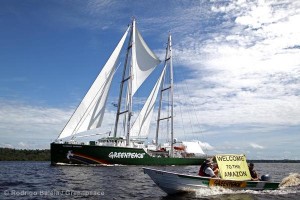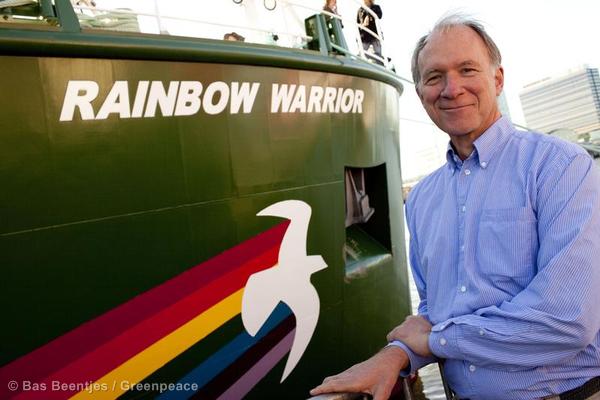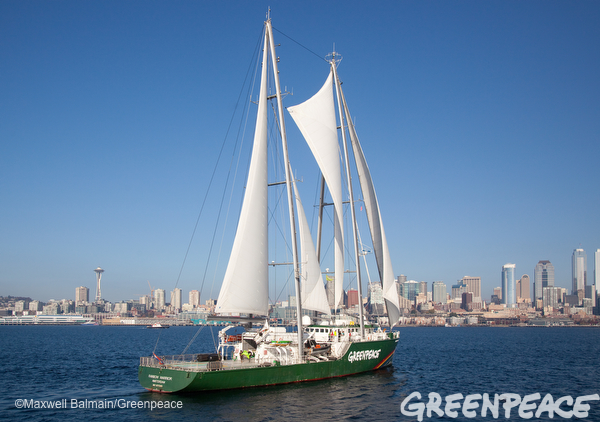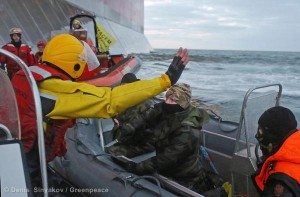From its first voyage to a nuclear test site in 1971 to the recent seizure of theArctic Sunrisefollowing a peaceful protest against Arctic oil drilling, ships have facilitated Greenpeace’s journeys to the frontline of environmental destruction.
TheRainbow Warrior IIIis currently sailing along the West Coast with its first American stop in Seattle before it heads south to Portland and San Francisco. Built with innovative and environmentally-friendly technology, the ship is a multi-purpose vessel. Along with carrying actions equipment and a communications hub, the ship is designed so scientists can conduct research right on board.
French agents bombed the originalRainbow Warriorin 1985killing Greenpeace photographer Fernando Pereira.
Hear below fromRainbow Warrior Captain Joel Stewart as he tells us why he started sailing for Greenpeace and how this ship tour is a special one.
How did you become a Greenpeace ship captain? What did you do before?
Captain Stewart:My first voyage as a Greenpeace captain was in 1989 on the 2nd Rainbow Warrior. I worked on fishing and cargo vessels in Alaska for several years before. One of the key factors in my decision to work with Greenpeace was the Exxon Valdez disaster. I wanted to work for an environmental group with a sailing vessel that makes a positive impact on the world. I really enjoy working with my shipmates and colleagues in Greenpeace and feel it an honor to be at the helm of our new sailing ship.
Why does Greenpeace have ships?
CS:Greenpeace has a long tradition of using ships in campaign work. It allows us to go to the high seas, across borders, and to remote areas.
Our vessels are campaign tools which include elaborate communications capabilities, action and research equipment.

In its first time in Brazil, the ship sailed through the Amazon to support the campaigns for a zero deforestation law.
Having ships enables us access the remote regions of the world. We are able to take campaigners, researchers and activists to witness environmental crimes or to document pristine areas that deserve protection. We have communications facilities on board to spread our message and images to educate people about issues.
Our ships are also iconic images that attract people to our meetings and workshops where we can facilitate communities to find solutions and improve environmental health.
How does Greenpeace use its different ships? For instance, why was the Arctic Sunrise chosen for the recent action in Russia against Gazprom while the Rainbow Warrior is on a ship tour?
The new Rainbow Warrior is the first time that Greenpeace has designed and built a vessel specifically for our needs.
The Rainbow Warrior can go up to the ice, but not through thick ice. Our other two vessels; the Arctic Sunrise and the Esperanza are ice class. The Arctic Sunrise is our best ship for the ice with full icebreaker class. It is a tough vessel with a thick hull shaped so that heavy ice pressure will not crush the shell. We hope to get it released from Russia soon, but our most urgent priority is getting our crew and journalists freed.
How did you react when you heard the news about the Arctic 30 from Russia?
I felt shock at the heavy handed arrest and dismay that they would be held for so long. I really feel sorry that my friends and colleagues are suffering in such poor conditions that they clearly do not deserve.
Piracy charges are completely ludicrous by any legally accepted use of the world.
I participated in a nonviolence trainingon board the Arctic Sunrise last summer with many of the people that are now incarcerated. They are good, peaceful people with honorable intentions that are dedicated to making our planet a better place to live, for us and our future generations.
Our shipmates and colleagues are still imprisoned in Russia after more than one month for peacefully trying to save the Arctic from environmental catastrophe.
They could face 15 years of imprisonment which is unthinkable to me. The moral crime of turning the Arctic into an oily wasteland fueling a climate spinning out of control is the real threat.
Gazprom and Shell have combined their enormous resources to make a full scale attack on the pristine waters of the Arctic Ocean. As dangerous as this is to this fragile frozen ecosystem, adding more CO2 to the atmosphere will be one of the tipping points that will send out climate spiraling out of control.
With the worlds oceans facing the highest levels of acidification in 300 million years we must get atmospheric CO2 levels back down to 350ppm or face catastrophic climate disasters in the near future.
Exploring for fossil fuels in extreme frontiers is extremely reckless. The Arctic, the deep oceans, tar sands, fracking etc…is not the way forward.
The traditions of nonviolent peaceful protest are well established, and the democratic rights of the people to live in a clean planet are fundamental to global society. We can not allow the profit motivations of large corporations to influence governments to act against the interests of the people.
How do Greenpeace ships fit in with other maritime culture and with other sailing or fishing vessels?
Greenpeace has a lot of credibility in the maritime community for the way we professionally operate and maintain our vessels. We have gained the respect of coast guards and law enforcement agencies around the world for out peaceful nonviolent tactics.
We have forged alliances with many sustainable fishing fleets and communities for our shared vision of healthy oceans.
Nautilus, a sailing unionand many other labor organizations are calling for the release of our crew and official protest at the substandard treatment they have received.
The Netherlands Minister of Foreign Affairs has initiated an arbitration case at the International Tribunal for the Law of the Sea (ITLOS) and has lodged an applicaton for an immediate order to release the Arctic Sunrise and the crew and journalists that were onboard.
Why should people come out to see the Rainbow Warrior this fall during its West Coast tour?
The Rainbow Warrior is an exciting vessel to see. With the impressive 55m/180 ft A frame masts, it is easy to find in the harbor. It is a unique vessel from one of Europes top large sailing vessel naval architects. We have an engaging crew, volunteers and campaigners that give tours, and can answer questions about Greenpeace.
The Rainbow Warrior is a big investment for Greenpeace’s future, and this ship is already starting to make history. We would like all of you to come meet us and be a part of the movement to improve our world, and our shift away from toxic technologies.
I hope you will stand with us; the crew of the Rainbow Warrior and Greenpeace USA in supporting our Arctic 30 climate heroes.






